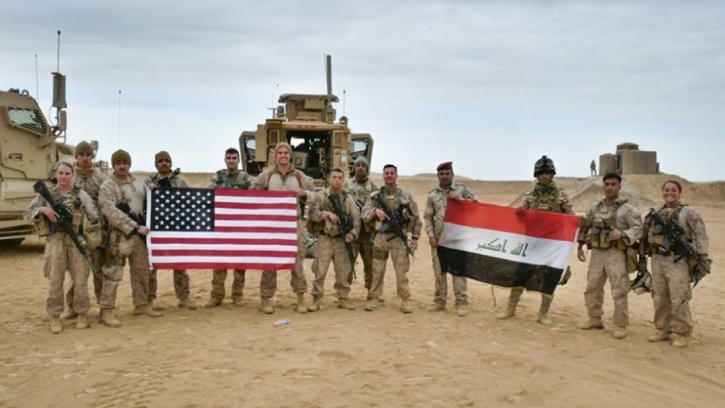
Over the past year, mindful that I have been blessed to live under Oregon’s tranquil skies, I reflect upon the Palestinians and Lebanese who begin and end theirs days under skies fraught with drones and bombers.
I also think of the Israeli pilots who have since 8 October 2023 dropped over 70,000 tons of bombs on a densely populated strip of land about the size of Las Vegas. Have they considered the reality of their missions? Do they see themselves in the German SS soldiers who turned on the gas in the death chambers of Auschwitz? And what of American politicians and corporate media’s complicity in Israel’s year-long genocide?
These questions, and more, led me to recall a well-known statement made in 1925 by the 30th president of the United States, Calvin Coolidge; a statement that has come to define US policy at home and abroad: ‘The chief business of the American people is business.’
Economic hegemony has been the cornerstone of US policy in the Persian Gulf since the end of the Second World War. America’s ‘special relationship’ with Israel, a term first coined by President John F. Kennedy in 1962, is founded on business. Economic supremacy was also at the heart of the oil-for-security bargain that the United States sealed with oil-rich Saudi Arabia after World War II.
The raison d’être for the United States and Israel in the region has been carpetbaggery--they have become the two-headed serpent of the Middle East. For the United States the goal has been domination of the region’s energy resources and vital trade routes. For the Zionist Israelis, it has been the establishment of colonies on stolen land and use of all of Palestine’s water and other resources for the sole benefit of Jewish colonists.
Israel has been America’s regional enforcer, assassinating leaders and terrorizing countries that refuse to abide by its rules. As General Alexander Haig, then-secretary of state, averred in 1982, ‘Israel is the largest American aircraft carrier in the world that cannot be sunk.’
Washington’s landed carrier is a projection of US imperial power in the Middle East. It has been the linchpin of America’s ongoing doctrine of force and economic imperium for a half-century.
In return for Israel’s services, Washington has invested heavily in its security, providing huge sums in military aid ($3.8 billion annually), supplying and co-producing advanced weaponry, security and intelligence systems, and giving diplomatic cover against Israel’s numerous violations of international humanitarian law.
The US imperial plan to create a ‘new’ reality in the Middle East has been in progress for some time. Force and economic incentives have been its bedrock. When warfare has failed, as has been the case in Afghanistan, Iraq and Syria, Washington has placed greater emphasis on economic incentives, like the Abraham Accords, to subjugate the region.
Since the late 1970s, Israel has been central to US imperial strategy. As the military and economic hub of the region, it was positioned to protect and buttress ‘American’ interests. The reality envisioned by Washington also included removing any and all obstacles to US hegemony.
The geopolitical alignment of the United States and Israel can be sourced to 1962 when Washington began providing missiles to Israel. And in 1974, when the Gush Emunim (Block of the Faithful) movement was formed to promote Jewish religious settlement on the occupied West Bank, the United States failed to take effective action, as it has to this day.
Throughout the 1970s, the United States sought to protect its interests through its Twin Pillars policy, by acting through and empowering regional enforcers, Iran and Saudi Arabia. With the Iranian Revolution of 1979, that policy collapsed as did the regime of the Shah of Iran. This landmark event gave birth to the 1980 Carter Doctrine, declaring that the United States would use every means, including military force, to protect ‘its’ vital interests in the Persian Gulf.
With the loss of its ‘stable’ pillar in Tehran, Washington looked increasingly to Israel, as well as Saudi Arabia, to uphold its regional interests. Then-Senator Joe Biden, in 1986, made America’s objectives explicit, declaring that Israel was the best $3 billion (annual) investment the United States has ever made, and that if Israel did not exist, the United States would have to invent it to protect American interests in the region.
American imperial power was manifested when the United States invaded Iraq in March 2003. President George W. Bush’s national security advisor, Condoleezza Rice, explained the objectives of the invasion in an editorial for the Washington Post in August of that year. She wrote, ‘Today, America and our friends and allies must commit ourselves to a long-term transformation in the…Middle East.’
The devastation, failure and upheaval that followed Bush’s wars in Afghanistan and Iraq to remake the region through force have not lessened Washington’s determination to engineer a ‘new’ Middle East aligned with Israel.
The large cadre of business-minded, monied interests surrounding President Donald Trump (2017–2021) concluded that regional integration/transformation could be achieved through economic manipulation. To that end, the Trump administration brokered the 2020 Abraham Accords, normalizing diplomatic and economic relations among Israel, the United Arab Emirates, Bahrain, Morocco and Sudan.
President Joe Biden has invested in strengthening the accords, pushing for further military and economic integration. By September 2023, Washington and Tel Aviv were confident that they were on the cusp of achieving their objectives and that Saudi Arabia could be persuaded to agree to normalisation.
The administration also presumed that Palestinians had been marginalised and their cause forgotten, and that the Axis of Resistance — Iran, Syria, Hamas in Gaza, Hezbollah in Lebanon, Ansar Allah in Yemen, Islamic Resistance in Iraq had been weakened.
Confident of success, prime minister Benjamin Netanyahu brazenly presented the US-Israeli plan at the 78th session of the UN General Assembly in September 2023. He described their scheme as ‘monumental and transformative,’ and that their agreements would usher in an era of security and prosperity across the region.
He held up a map titled ‘The New Middle East,’ depicting Israel from the Jordan River to the Mediterranean Sea--without any trace of the occupied Palestinian territories. Netanyahu boldly stated that the Palestinians should not stand in the way of future normalisation agreements, and preened that Israel was close to an historic agreement with Saudi Arabia.
As part of the ‘new’ Middle East economic initiative, Netanyahu also hailed the advent of the India-Middle East-Europe Economic Corridor (IMEC), an expansion on the Abraham Accords.
The IMEC--America’s largest geopolitical project for the region--was unveiled by President Biden at the September 2023 G20 summit in New Delhi.
The proposed trade venture fit into Washington’s strategic agenda to counter China’s Belt and Road Initiative and to cement relations between Saudi Arabia and Israel. The BRI (New Silk Road) route connects Asia to Europe via the Middle East and Africa, with Central Asia, Iran and Turkiye the essential links.
Conversely, the US-designed route--a seamless infrastructure of ports, railways and roads linking India with the Middle East and Europe--relied on Israel as a link between east and west. Israel’s port at Haifa would have become a consequential economic hub.
In addition to extending US power in the region, the project was viewed as laying the foundation for a ‘new era’ of integration and cooperation among Israel and US regional janissaries. The power politics behind the trade initiative was revealed in the exclusion of Palestine, Turkiye, Iraq, Iran, Qatar and Oman.
October 7, however, torpedoed the US-Israeli agenda. It has undermined, if not ended, the IMEC enterprise and weakened normalisation plans. The incursion also revealed a weakened US imperium, desperate to keep Israel, its largest investment and landed aircraft carrier in the Middle East afloat. The war on Palestinians in Gaza is remaking the Middle East, but not in the way the United States and Israel had hoped.
The seeds of catastrophe were planted in the heart of the Islamic world 107 years ago when the British regime unceremoniously promised the land of Palestinians to the Jews of Europe. Since then, untold numbers have been killed, heritage sites destroyed and ecosystems devastated.
It has escaped the United States and Israel that they cannot bomb the resistance into submission; they cannot exploit the region’s resources; and most importantly, they cannot change it.
For one-year, the intrepid resistance of the Palestinians has given the region hope for a new direction — one free of Zionism and imperialism, militarism, corporatism and those who reap but do not sow. That time will come.
The writer is a political scientist specializing in the history, politics and governments of the Middle East.





































